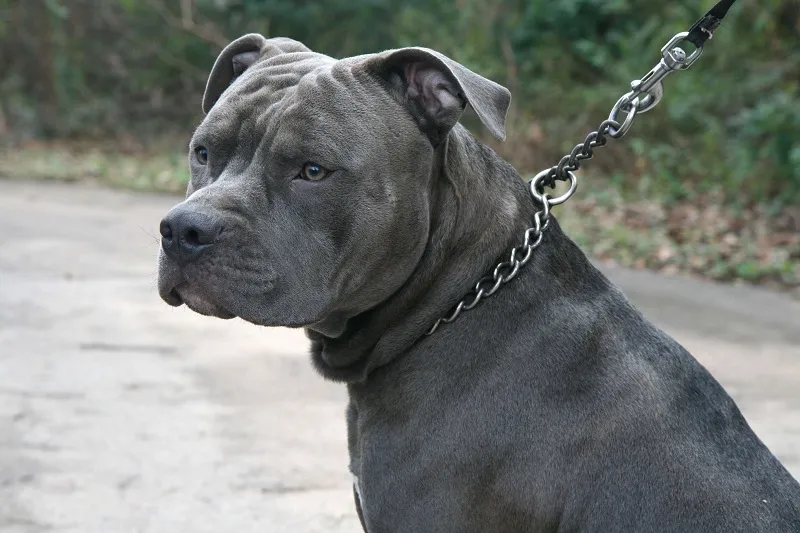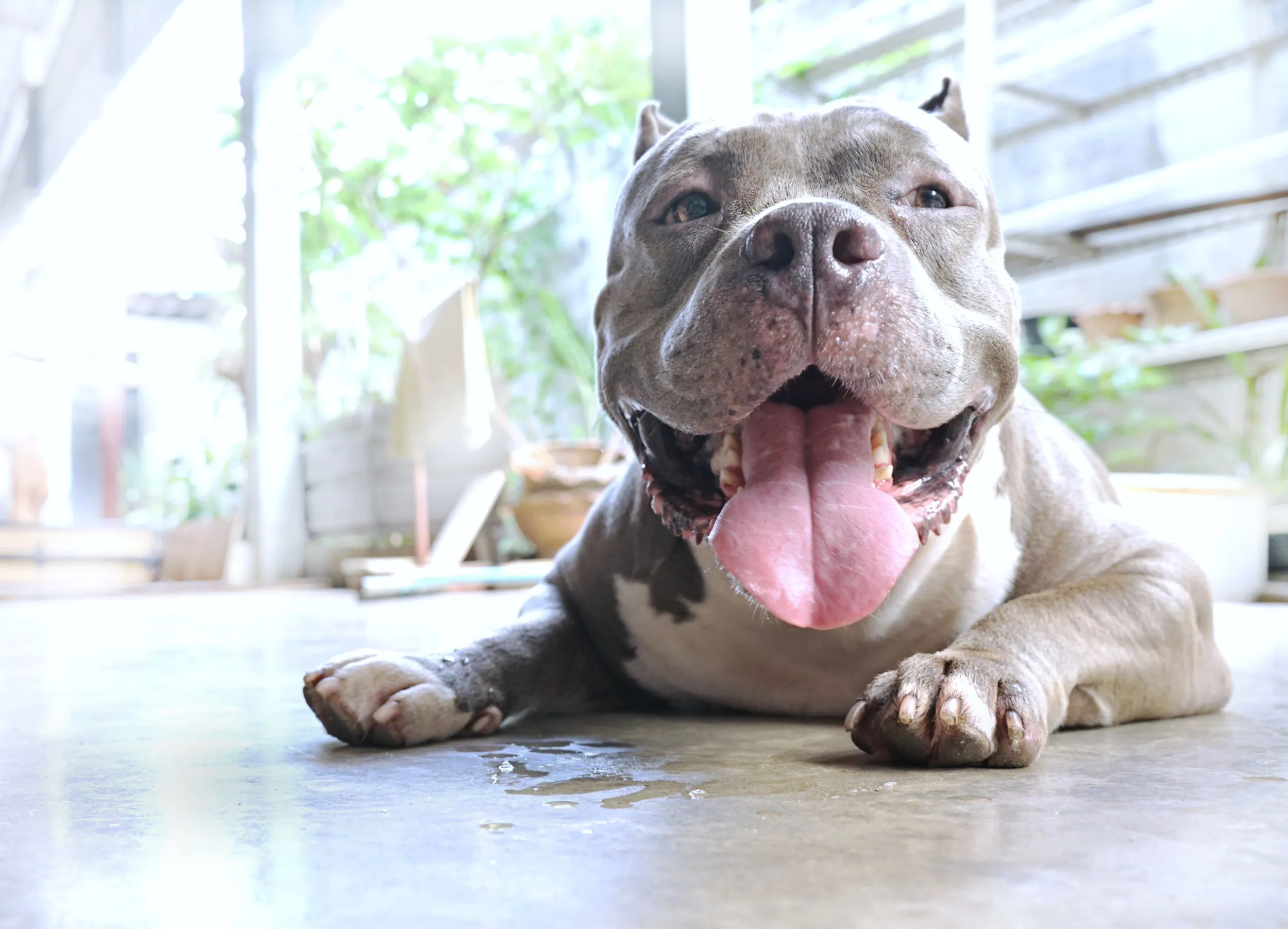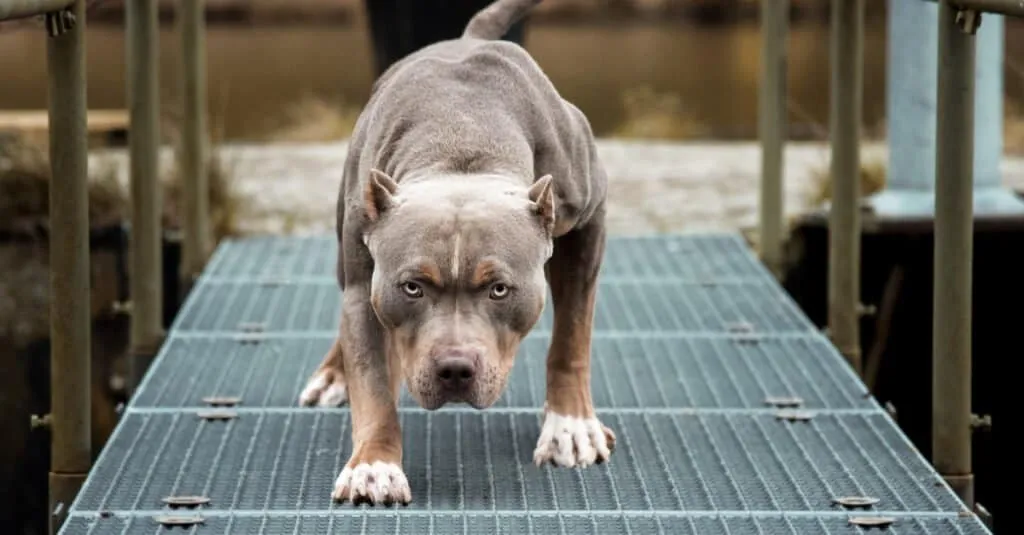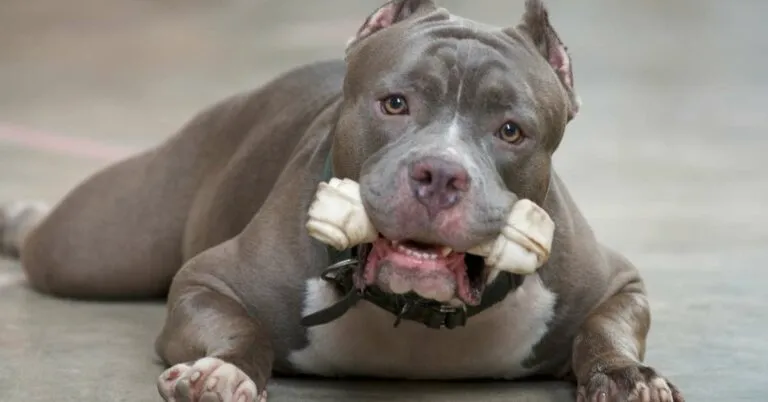The fascinating mix of American Bulldog and American Pit Bull Terrier has distinct speciality characteristics that make it an ideal companion for busy and caring households.

Get ready for gusts of delight–the American Bulldog Pitty Mix is equally enticing and full of surprises!
With loyalty and protective instincts, the American Bulldog Pitty Mix’s inexhaustible activity will keep you on your toes and warm.
If you are thinking about getting one of these happy dogs or want to learn more about the American Bulldog Pitty Mix, this information will provide you with more than just the basics.
American Bulldog Pitty Mixs: Breed Overview
The American Bulldog Pitty Mix is a medium-sized, short-haired dog with a particularly stocky build. They are also incredibly friendly—in most circumstances. However, they have a negative reputation.
Some American Pit Bull Terriers may be aggressive. In many situations, this is attributable to poor genes or inadequate upbringing.
Pit Bulls, like any other dog, can become unruly if mishandled. That does not imply that the breed as a whole is hostile.
Instead, the majority of American Pit Bull Terriers are sweethearts. Despite their reputation, many Pit Bulls maintain trust in humans.
The Height: 17–21 inches
Weight: 30–70 lbs.
Lifespan: 9-13 years.
Colours: All colours and patterns except Merle.
Ideal for: Active families with older children may do best with a lone dog.
Temperament: Outgoing, affectionate, strong-willed, sensitive, and excitable
American Pit Bull Terriers require daily exercise, but because their activity levels differ, some require more exercise than others. They are also mentally active, so you cannot simply leave them in a yard all day.
Many owners appreciate these dogs because they have a kind and compassionate heart. They’re friendly when properly raised. However, many are hostile towards other dogs. They’re a no-nonsense canine who dislikes being challenged by other dogs.
American Bulldog Pitty Mixs Puppies

As one might expect, American Pit Bull Terrier puppies are adorable. They have limitless energy reserves, therefore they will spend much of their waking hours running around. However, they, like other pups, require plenty of sleep. Expect them to spend their day napping and running around.
properly socialized. Pit Bulls are well-known for their love of people. They require attention and socializing from a very early age. What does it mean to properly socialize a Pit Bull puppy?
First, you must expose them to all of life’s experiences in a favourable manner before the age of 14 weeks. This means they need to interact with pleasant people and pets and be rewarded for their confident behaviour.
You should consult your veterinarian for safe outing suggestions, but most experts recommend that your dog meet five to ten new individuals and experience a different environment each week.
Second, you should begin training your puppy as soon as you get it home. Pit bulls are eager to please, but they are also psychologically alert. They will adapt to training quickly and effortlessly, so take advantage of this while they are young.
Finding a trustworthy breeder is critical when seeking a Pit Bull puppy. Unfortunately, these dogs are still being illegally bred for dogfighting.
As a result, it’s critical to select a breeder who raises family-friendly puppies. Be aware of pet retailers and backyard breeders, and inquire about temperament tests.
You can also find American Pit Bull Terriers in shelters. However, it’s critical to inquire about temperament testing.
Many good Pit Bulls wind up in shelters and rescues. Furthermore, when you purchase an adult dog, you can assess their temperament and know what you’re getting.
Temperament and Intelligence of the American Pitbull Terrier

American Pit Bull Terriers are complex dogs with diverse temperaments, which have resulted in numerous misunderstandings over the years. Genes influence how a dog behaves, but how the dog is raised is also important.
In most circumstances, Pit Bulls are friendly. They enjoy humans and would make excellent family dogs for households with older children.
As with any breed, they must be handled with care, and contact with children should be closely monitored. Pit bulls are also quite active. They have tremendous energy and love to play. They can also be goofy!
American Pit Bull Terriers were originally designed as combat dogs. Despite having this bred out of them, they maintain their self-assurance and confidence. For this reason, they make excellent watchdogs. However, if not properly socialized and managed, they can become territorial and violent.
Pit bulls require continuous training and socializing from a young age. You should be very careful while socializing them with other dogs because they can be inherently aloof or hostile toward other canines. Even with extensive socialization, they are not always a good fit for multi-dog households.
Are These Dogs Okay for Families?
American Pit Bull Terriers may be an excellent option for some households. As high-energy dogs, they thrive in active households. Exercise is essential for ensuring their well-being and suitability for your home. We also recommend them exclusively to experienced dog owners.
American Pit Bull Terriers can be very affectionate and dedicated to children. However, they may be oblivious of their magnitude.
It is not uncommon for them to accidentally knock youngsters over, particularly young canines. Consider this when evaluating whether this breed is a suitable fit for your household. We always encourage supervision when Pit Bulls are near youngsters.
Does This Breed Get Along Well With Other Pets?
American Pit Bull Terriers aren’t known to get along with other pets. Some are highly hostile toward other dogs, particularly those of the same gender, which is a frequent feature among guarding breeds.
Responsible breeders strive to make their dogs less aggressive, thus some puppies are far less aggressive than others. Pit bulls do not get along well with cats or other small animals. They have a strong prey drive, hence they frequently chase cats.
Like other Terriers, this urge cannot be “trained out.” They are large enough to hurt a cat, unlike most other Terriers.
What to Know When Owning an American Pit Bull Terrier
Food and Diet Requirements
American Pit Bull Terriers can maintain great health on almost any high-quality dog food, with no specific dietary requirements.
More active means more calories, and sometimes this corresponds with greater calorie foods.
While younger dogs are relatively energetic, senior dogs often slow down considerably. Observe the overall condition of your dog and adjust the food accordingly.
Puppies cannot rely on the same diets as older dogs and must be fed foods that suit their specific dietary needs. This is known as puppy food; puppy foods should be given until the dog matures into adulthood.
Sometimes dogs have some health issues requiring them to have special diets. Most Pit Bulls are quite healthy, and that doesn’t rule out the chance they’ll have health problems. You might have to consult with your vet to know what dog food to purchase for your pet.
Exercise
Ideally, you should engage in 1-2 hours of daily activity. Of course, this should be divided into multiple sessions.
Additionally, puppies have different activity requirements than adults. They often require less activity, divided into even smaller sessions.
The wrong form of activity can harm your dog’s joints and bones to develop improperly, however, the evidence for this is limited. However, we recommend avoiding stairs and high-impact exercises.
Senior dogs may remain as energetic as adults, or they may become less active.
Everything depends on how they age. It is critical to prevent obesity in older dogs, yet they may not require as much activity as they did when younger.
Walking and running are excellent choices, and you can even teach them to swim. However, their mental wellness is also vital.
Puzzle toys and training sessions can help keep young minds active and interested. Otherwise, Pit Bulls can become extremely destructive due to boredom.
Training
Pit bulls must be continuously trained. They’re intelligent canines who pick up on training rapidly. They also enjoy attention and positive reinforcement.
As a result, they are quite easy to train, despite their tendency to be stubborn. Harsh training techniques should be avoided (as with any dog). Pit bulls are extremely sensitive and react negatively to severe corrections.
Too much can cause them to lose focus during training or become aggressive.
Puppyhood is the ideal time to begin training Pit Bulls. Puppies are learning about training and obedience in general, so start slowly and early. Consistency with your house rules can help your dog learn what is expected of them early on.
Short, frequent training sessions work best. Begin with 5 minutes and gradually increase to roughly 10 minutes as you get older. Always end the session on a positive note, before your dog tyres or you become frustrated.
Group courses are an excellent method to introduce socializing into your dog’s life in a controlled setting. You can enrol in group classes as soon as your puppy is inoculated.
Pit Bulls are quite energetic, therefore it’s vital to exercise them before beginning training. Otherwise, they may be overly enthusiastic and distracted throughout training.
Grooming
A Pit Bull does not require extensive grooming. Their short fur sheds, but it is so short that they create little fur. We recommend brushing them at least once a week, or daily if they shed excessively.
A grooming glove is frequently the finest option for deshedding. If your dog sheds infrequently, you can use a soft bristle brush.
Brushing your dog regularly helps to maintain their fur and skin healthy and spreads their natural oils. Their coats are quite good at remaining clean, and a weekly brushing session can remove any dust and debris that has gathered during the week.
They may need a bath every 2-4 months, depending on how dirty they get outside. Bathe them only once a week to avoid stripping away their natural oils.
You will need to cut your dog’s nails regularly, just like any other dog. More active dogs may not require their nails clipped as frequently. Overgrown nails can be extremely uncomfortable and splinter, causing infections and more discomfort.
In addition, you should brush your dog’s teeth regularly. A couple of times each week is ideal, but more is even better. Use a dog-friendly toothbrush and toothpaste, as human toothpaste includes hazardous chemicals.
Begin grooming your dog early, even if it doesn’t require much as a puppy. Starting early helps to desensitize them to grooming, which makes your job much easier later on.
Health & Conditions
American Pit Bull Terriers are generally regarded to be healthy dogs. Their typical lifespan is 13 years, but many survive far longer. However, like any dog, they can acquire health problems. Pit Bulls, for example, have approximately 20% hip dysplasia.
While certain breeds have significantly higher rates and the majority of cases are classified as moderate, 20% is still a significant number. Responsible breeders will check their parent dogs for hip dysplasia before breeding them.
Pit Bulls can also have luxating patella, which is when the kneecap falls out of place. This disorder can lead to pain and difficulties walking.
In some situations, the consequences can endure a long time, and surgery may be required. Thyroid problems may also arise. The Pit Bull’s thyroid gland may not produce adequate hormones, resulting in weight gain and lethargy. Fortunately, medicine can replenish the deficient hormone.
Male versus Female
Male Pit Bulls are slightly taller and heavier than females. However, this is not always true. Males have larger muscle mass and are often stockier. Females are similarly stocky, with some having less muscle mass than males.
Aside from that, male and female Pit Bulls are virtually identical. Some argue that girls are eager to please, but males may be more aggressive. However, this has not been scientifically verified, and individual dogs can differ significantly. Sex does not accurately predict a dog’s temperament.


